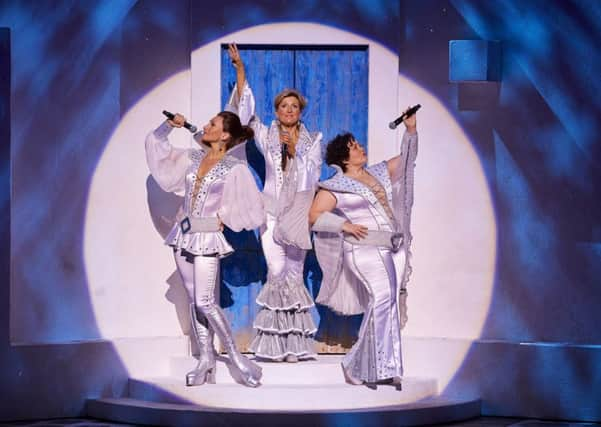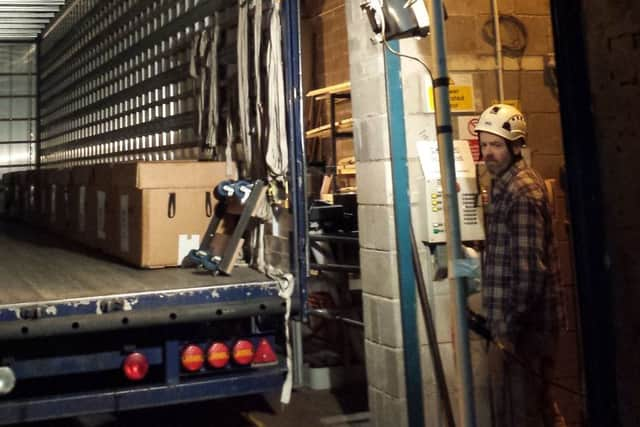Joyce McMillan: Behind the scenes at the Edinburgh Playhouse


Today, the show in hand is the current Bill Kenwright touring production of the romantic musical Ghost; around us, the set is already almost in position for the first act, its backdrop of the New York skyline dominating the stage.
Yet 48 hours from now, this huge structure – the sets, the gauzes, the dozens of lights, the furniture and props, the rows of costumes hanging in the wardrobe space just behind the stage – will be long gone from Edinburgh, already being nudged into place for Monday night’s opening performance at Nottingham Playhouse; and their place will have been taken by the very different stage world of the smash-hit Abba tribute musical Mamma Mia!, the Playhouse’s 2016 Christmas show. And Skeggs is the man who will preside over this massive transition, as he does on 20 or more weekends a year, as the UK’s biggest stage shows come and go from the Playhouse, now part of the nationwide Ambassadors group.
Advertisement
Hide Ad“As soon as the lights go up after the last performance of Ghost tonight,” he explains, “we’ll bring in the safety curtain, and start packing up the show. This is a relatively simple staging of Ghost, compared to the huge high-tech version we saw in 2013, so it can all be packed up into five container-sized trucks. There will be 11 Playhouse crew on the job, and about eight or ten people from the touring crew of Ghost – about 20 altogether.


“We should finish about 4am; then by late morning, the trucks for Mamma Mia! will be rolling in from their last date in Cardiff – six of them, this time round. We’ll work on until about 10pm on Sunday with the Mamma Mia! crew, unloading the trucks and putting everything in place. And then we’ll have Monday to finish off and run checks, before the dress rehearsal on Monday evening.”
It’s a huge physical task, in other words – one that is still fairly labour intensive, and, to Skeggs’s regret, male-dominated. He’s keen, though, to show me one impressive piece of technology that has helped to reduce the sheer muscular effort involved. The Playhouse is built on a steep slope at the Greenside below Calton Hill, a place of entertainment in Edinburgh since mediaeval times; and since the mid-1990s, truck access has been via a dock door on the lane behind the theatre that allows the drivers to back their giant containers onto a 40 ton lift just inside the building, which then raises the whole container 20 feet up to stage level, for rapid unloading just feet from the stage.
“It’s an interesting job, this,” says Skeggs, over a coffee in his office. “If I was in the West End, I’d be known as the Master Carpenter, and in a way I’d prefer that. I trained as a carpenter before I ever worked in theatre. And like most people in this business, I got involved by chance, through personal contacts, when I was a student in London in the 1980s. I took to it like a duck to water, quickly became a deputy master carpenter, toured with Cameron Mackintosh shows for many years; then in 1995 I came to Edinburgh with the huge original production of The Pantom Of The Opera, and just fell in love with the place – so when a permanent job here came up, I jumped at it.
“The job is not just technical problem-solving – in fact most of that looks after itself, particularly with the bigger shows, because they are all planned down to the last detail. There’s a big element of people management involved – I tend to rely on humour, as I’m not a shouty type. And it is a changing industry; there’s a great deal of health and safety work nowadays, as there should be.”


Yet Skeggs still seems like a happy man, as he walks me up to the high fly floor above the stage to look at a much more traditional piece of technology, the system of rope pulleys – still hand operated – that fly lighting-bars and scenery in and out of position. “I can have anything from two to eight people up here on the ropes during a show, depending on how complex it is,” he explains.
Advertisement
Hide Ad“One thing that bothers me, actually, is that here we are in Edinburgh running the biggest proscenium arch theatre in the UK, and employing hundreds of people in the course of a year, whether it’s stage work, wardrobe, or whatever. And yet there seems to be relatively little interest from schools and colleges, now – less than there was a decade ago – in introducing students to what goes on here, and encouraging them to think of a career in theatre. Because it is a great life, you know,” says Skeggs, as he leads me back to the stage door, and looks out into the yard as if he expects a 22-truck show to roll up at any moment. “I’ve been doing it for 30 years now, one way or another. And d’you know, I still love every minute.” ■
*Mamma Mia! is at the Playhouse, Edinburgh, until 7 January.